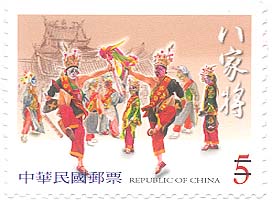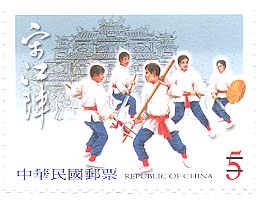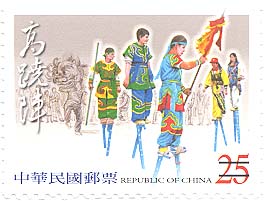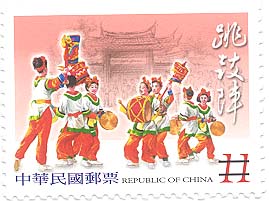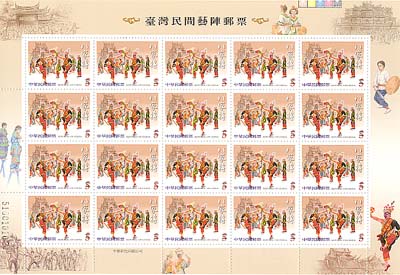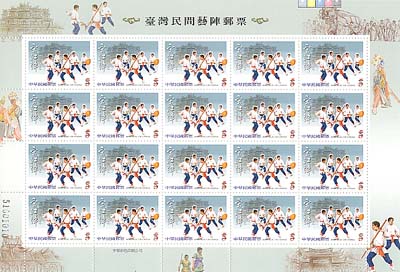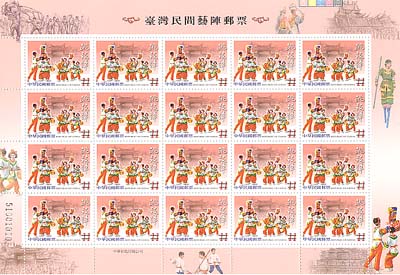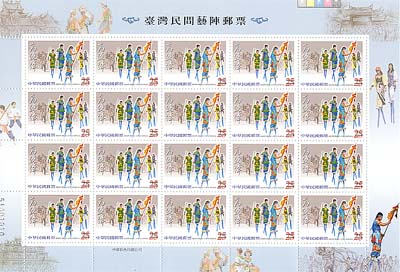Sp.461 Yijhen: Taiwanese Folk Art Performance Postage Stamps
| Stamp SN | D461 |
|---|---|
| Stamp Name | Sp.461 Yijhen: Taiwanese Folk Art Performance Postage Stamps |
| Stamp Cat Standard | Special Stamps |
| Stamp Cat | Festivals, Theater, Sports, Society, Activities |
| Issue date | 2004-05-11 |
| Suspersion date | |
| Dimension of stamps(mm.) | 40 x 30(mm) |
| Size of souvenir Sheet (mm.) | |
| Printer | China Color Printing Co., Ltd., R. O. C. |
| Drawer | Hung-tu Ko |
| Designer | |
| Photographer | |
| Engraver | |
| Creative Director | |
| Sheet composition | 20 ( 5 x 4 ) |
| Print color | Colorful |
| Process | Deep etch offset |
| Paper | Phosphorescent stamp paper |
| Back | |
| Perforation | 11 1/2 x 11 |
A staple of temple fairs and religious festivals, yijhen, a general category of various traditional Taiwanese folk art performances, is gradually fading from view due to the industrialization and modernization of society. Yet the sight of yijhen never fails to evoke warm memories of childhood. In order to give ROC nationals a deeper understanding about the island of Taiwan, Chunghwa Post is issuing a set of four stamps entitled “Yijhen: Taiwanese Folk Art Performance.”
In traditional Taiwanese society yijhen folk art performance played an important role in the cultural life of the common people. In the agricultural society of yesteryear, it was used in rituals to express people’s gratitude to the gods during temple fairs and religious processions and was also used as entertainment for the common folk. During the Ming and the Ching Dynasties, the early Han Chinese settlers brought yijhen with them
when they made the journey from mainland China across the strait to Taiwan. In the 400 years since, yijhen has developed into something that has both preserved its traditional Chinese spirit and yet also taken on the flavor of its locale. During the period of early settlement, Taiwan was a dangerous place, and some yijhen troupes had become self-defense organizations for their locales. The prevalence of religious activities fueled the development of folk dramas and yijhen. Apart from being entertaining, yijhen also functioned as a tool of education and as a defense mechanism that fostered solidarity among the people. Traditionally, a procession is held symbolizing a god or gods making an inspection tour of his or her territory on the eve of the god’s birthday or an important temple ceremony. During this kind of procession, local temples and businesses invite yijhen folk art performance troupes to join the parade. Most of these yijhen performers are amateurs and composed of people from the local communities.
The designs of the stamps follow:
(1) The Eight Generals: the “Eight Generals” can actually be performed by four, six, eight or more than ten persons. An eight-person troupe is the most common—hence the name. The “Eight Generals” is a solemn and mysterious troupe, employing the Four Gate, Seven Star or Eight Trigram battle arrays to capture goblins and monsters, so as to protect the people and keep the area safe.
(2) The Song Jiang Battle Array: the “Song Jiang Battle Array” is the largest and most impressive religious martial art troupe in Taiwan and it is very popular in Southern Taiwan. It is typically composed of 36 members, but some have 42, 56 or 72 members. In recent years, the Tourism Bureau has especially designated the “Song Jiang Battle Array” performed by troupes from Neimen Rural Township, Kaohsiung County as a unique local travel attraction. And troupes from Neimen have represented Taiwan several times in performance art exchanges in mainland China.
(3) The Drum Dance: the “Drum Dance” is the most energetic and rhythmic of all Taiwanese folk art performances. All about drumming and jumping, it is also called the Drum Flower Dance, Big Drum Flower or Playing the Big Drum. A troupe is normally composed of eight people, although there are also larger troupes of several dozen people. The performance is divided into the flags, the drums, the parasols and the gongs. It is mostly performed in a square-like formation, with the drums in the middle, the parasols in the front and back, and the gongs at the four corners. Movements are rhythmic and exacting. These are popular performances during temple fairs.
(4) Stilt Walking: also called stilt stepping, stilt walking takes real skill and a lot of practice. It is generally divided into the categories of theatrical stilt walking, which emphasizes singing and facial expressions, and martial arts stilt walking, which features all sorts of stunts and martial art movements. Most of these stilts are under three feet high, and these are called short stilts. Stilts over three feet high are called tall stilts.
(1) First Day Cover in small size to be sold at NT$2.00 apiece
(2) Folder especially prepared for the stamps to be sold at NT$5.00 apiece
(3) Folder with crystal mount for better protection of the stamps to be sold at NT$5.00 apiece
(4) Loose-leaf stamp album page with plastic cover to be sold at NT$8.00 apiece
(5) Pre-cancelled First Day Cover affixed with a
low-valued stamp to be sold at NT$ 7.00 apiece
(6) Pre-cancelled First Day Cover affixed with a complete set of stamps to be sold at NT$48.00 apiece
Sp.446 Regional Opera Series-Taiwanese Puppet Postage Stamps(A World at Hand)
Sp.446 Regional Opera Series-Taiwanese Puppet Postage Stamps(A World at Hand)
YOU MAY ALSO LIKE
By category
By Topic
By Year






